Running power meters measure your effort by analyzing the force you generate with each stride, providing insights beyond pace and heart rate. They account for factors like biomechanics and footwear, helping you optimize technique, pace, and endurance. Tracking power allows you to monitor efficiency, fatigue, and intensity in real time, informing better pacing and training adjustments. Keep exploring, and you’ll uncover how to use these numbers to boost your running performance effectively.
Key Takeaways
- Running power meters measure biomechanical effort, quantifying force and energy used during each stride.
- They provide real-time data on effort beyond pace and heart rate, aiding performance optimization.
- Key metrics include wattage, effort trends, and efficiency; calibration accuracy ensures reliable readings.
- Analyzing power data helps with pacing, fatigue management, and injury prevention during training and races.
- Consistent tracking and understanding of power numbers allow runners to refine technique and improve endurance.
What Is Running Power and Why It Matters
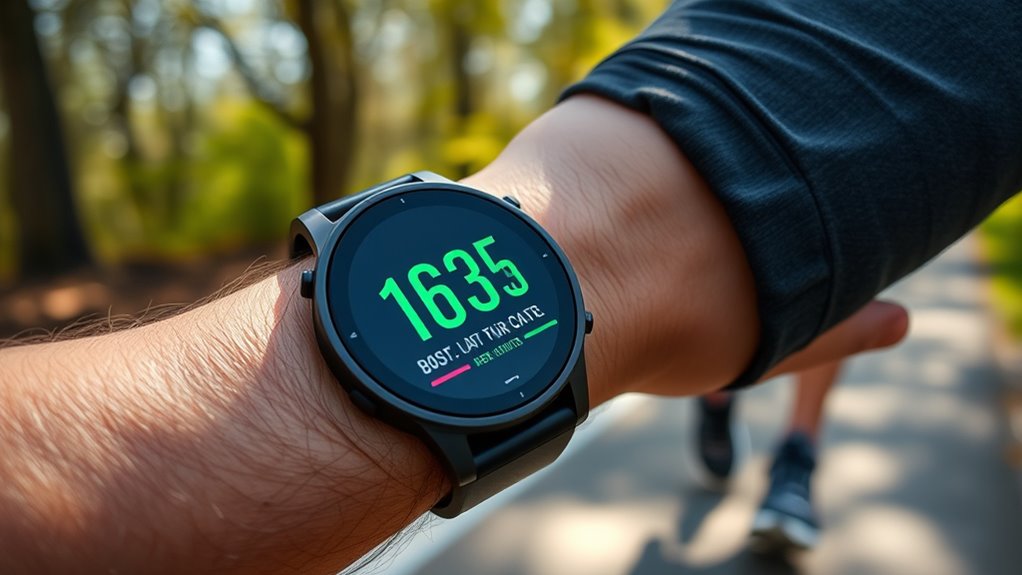
Have you ever wondered how runners measure their effort beyond pace and heart rate? Running power provides a direct measure of the work you do during each stride. It’s rooted in running biomechanics, capturing how force and movement generate energy. By quantifying your output, you can better understand your training and avoid overexertion. Running power accounts for footwear impact, recognizing how different shoes influence efficiency and force absorption. This data helps you refine your technique, optimize your stride, and improve endurance. Additionally, understanding how running power integrates with training technology can further enhance your performance insights. Monitoring Real-time metrics allows for more precise adjustments during workouts, leading to better results. Leveraging AI content clusters can also assist in analyzing your training data more comprehensively. Recognizing the importance of running biomechanics can help you identify areas for improvement and prevent injury. Ultimately, it reveals the true work you’re putting in, helping you train smarter and prevent injury.
Key Metrics Measured by Running Power Meters
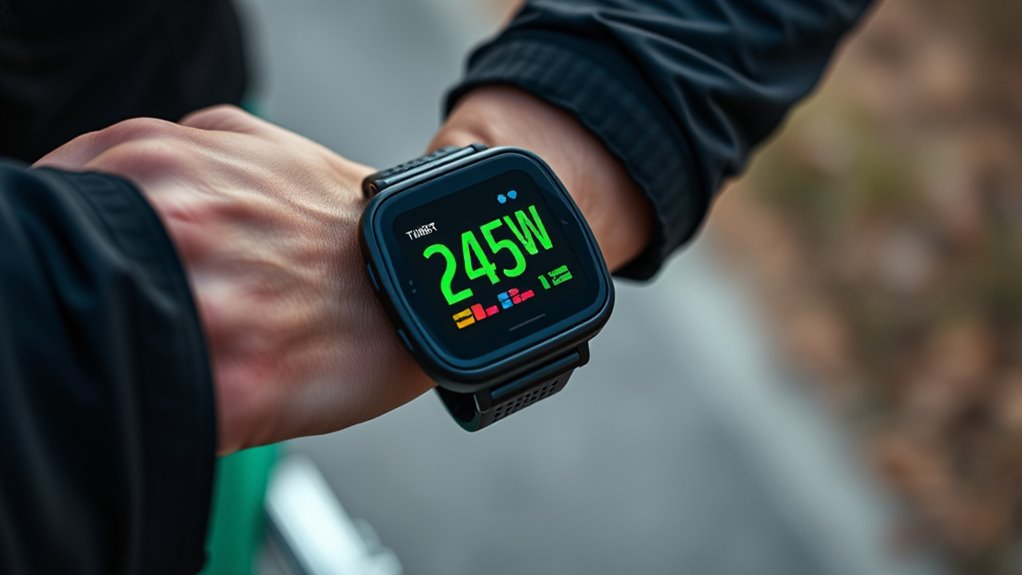
Running power meters track several key metrics that help you understand your performance. You’ll want to pay attention to power output accuracy, how it correlates with your heart rate, and the detailed breakdown of performance metrics. These insights can help you optimize your training and improve your running efficiency. Additionally, understanding performance metrics can guide you in making targeted adjustments to increase endurance and prevent injury. Recognizing the accuracy of measurements ensures that the data you rely on is precise and reliable for training decisions. Many advanced meters incorporate technology integration that allows for real-time data analysis, enhancing your ability to make immediate adjustments during training. Proper calibration of your device is also essential to ensure that the measurement data remains consistent over time.
Power Output Accuracy
How accurately do running power meters measure your performance? They rely on calibration accuracy and device consistency to provide reliable data. Even small deviations can impact your training insights, so understanding their precision and reliability matters. High-quality meters maintain consistency over time, ensuring your numbers reflect real effort. But variability can occur due to sensor placement, environmental factors, or wear. Here’s how different devices compare:
| Device Type | Calibration Accuracy | Consistency Over Time |
|---|---|---|
| Premium Power Meters | Very high | Excellent |
| Mid-range Devices | Moderate | Good |
| Budget Options | Variable | Inconsistent |
Trust in your device’s accuracy helps you push harder and train smarter. Regular calibration and mindful use of proper setup keep your data trustworthy.
Heart Rate Correlation
While power output provides valuable insights into your running performance, it doesn’t tell the whole story. Heart rate correlation helps bridge that gap, revealing how your body responds to effort. Your heart rate variability reflects your autonomic nervous system’s state, indicating fatigue, stress, or recovery needs. Running power meters often track heart rate alongside power data to give a fuller picture of your effort and endurance. Keep in mind, hydration influence can affect heart rate responses—dehydration may cause elevated heart rates even at lower power levels. By monitoring both metrics, you gain a better understanding of your physiological state during runs. This combined approach helps optimize training intensity and recovery, ensuring you’re not just running hard but running smart.
Performance Metrics Breakdown
Have you ever wondered what exactly running power meters measure? They track key performance metrics that help you optimize training and race strategies. These metrics include metrics like normalized power, cadence, and power zones. Understanding these helps refine your drill techniques and nutrition strategies for better results. Here’s a quick breakdown:
| Metric | What it measures | How it helps |
|---|---|---|
| Normalized Power | Intensity of effort over time | Adjust training intensity |
| Cadence | Steps per minute | Improve efficiency |
| Power Zones | Intensity levels | Tailor workouts to goals |
| TSS (Training Stress Score) | Overall training load | Prevent overtraining |
This data guides your decisions, helping you train smarter and run stronger.
Understanding Power Zones and Training Intensity
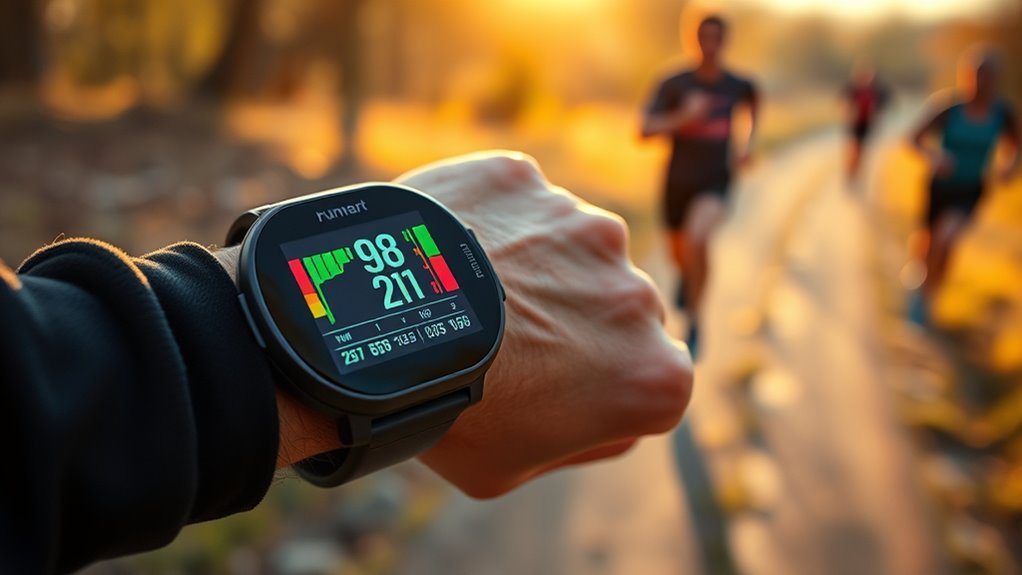
Understanding your power zones is essential for optimizing training and preventing burnout. These zones categorize your effort levels based on your power output, guiding effective workouts. For example, training in endurance zones helps build stamina and allows sustained effort over long distances. Incorporating interval training, which alternates between high and low intensities, can improve your speed and power efficiency by targeting specific zones. Knowing your zones enables you to structure workouts that match your goals—whether building endurance or increasing power. It also helps you avoid overtraining by staying within safe intensity ranges. By monitoring your power zones, you gain a clearer understanding of your effort and progress, ensuring each run contributes meaningfully to your overall performance.
How to Interpret Your Power Data During Runs

As you run, keep an eye on your power data to gauge how hard you’re working in real time. Recognizing patterns in your effort helps you stay within your target zones and avoid overexertion. Tracking these trends allows you to adjust your pace for a more efficient and effective workout.
Monitoring Real-Time Effort
Monitoring your running effort in real time requires paying close attention to your power data as you move. By tracking these numbers, you can adjust your pace to conserve energy and avoid burnout. If your power output spikes unexpectedly, it’s a sign to slow down and focus on maintaining a steady effort. Conversely, if your power drops too low, you might need to push slightly harder to stay on pace. This immediate feedback helps you refine pacing strategies during the run, ensuring you don’t overexert early or fade later. Staying aware of your power data allows you to respond proactively, optimizing performance and energy conservation. With practice, you’ll develop an intuitive sense of effort, making real-time adjustments second nature.
Recognizing Performance Trends
Interpreting your power data during a run reveals valuable performance trends that can guide your pacing and effort. By focusing on trend identification, you can spot whether your power output is steady, increasing, or decreasing. Interval analysis helps you break down your run into segments, making it easier to see how your pace responds to different efforts. For example, a declining trend might indicate fatigue, while a stable trend suggests you’re maintaining consistent effort. Recognizing these patterns allows you to adjust your pace proactively, preventing burnout or underperformance. Over time, analyzing your power data helps you refine your training zones and optimize your race strategy, ensuring you’re always responsive to your body’s real-time signals.
Monitoring Efficiency and Fatigue Through Power
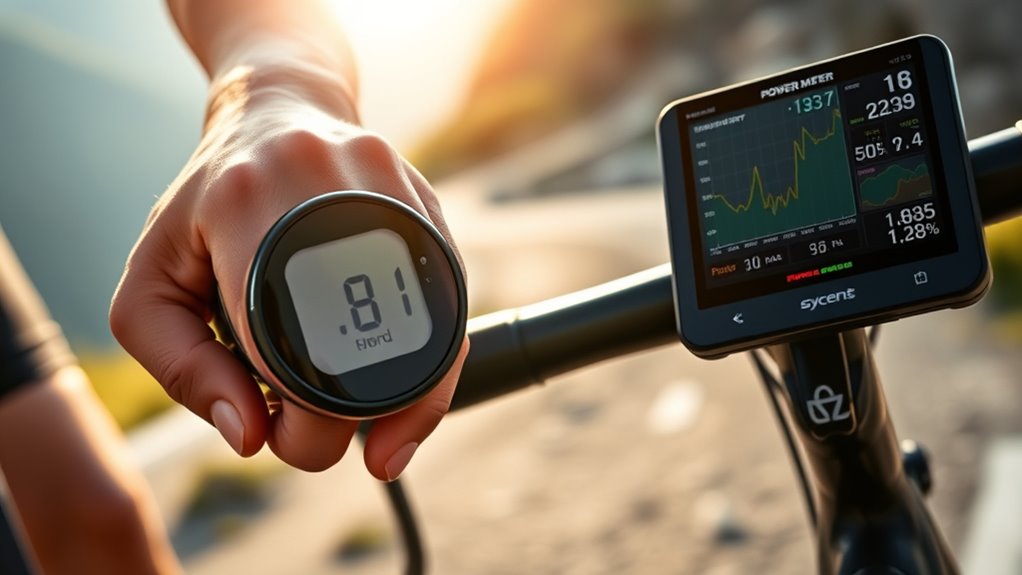
Ever wonder how you can gauge your running efficiency and fatigue levels in real time? Monitoring your power output helps you do just that. By tracking your running efficiency, you can identify when your form starts to decline, signaling increased fatigue. This insight allows you to adjust your pace or incorporate proper nutrition strategies to maintain energy levels. Consistently high or fluctuating power data may indicate overexertion, which raises injury prevention concerns. Using power meters, you gain immediate feedback on how your body responds during runs, helping you optimize effort and recovery. This real-time monitoring ensures you stay within safe limits, improve efficiency over time, and avoid overtraining. Ultimately, it keeps you informed and in control of your performance and well-being.
Using Power Data to Improve Your Race Strategy
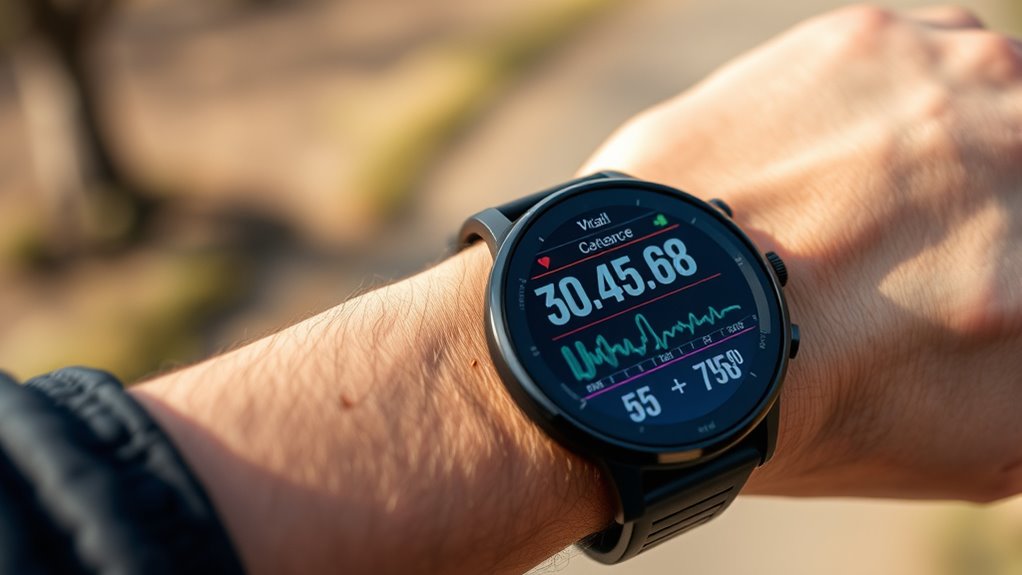
Using power data during your race can give you a strategic edge by helping you make real-time adjustments to your effort. To do this effectively, guarantee your gear is properly calibrated so readings are accurate. Next, focus on data synchronization; syncing your devices correctly prevents discrepancies that could mislead your pacing decisions. Here are three ways to leverage power data:
- Adjust your effort based on real-time wattage to stay within your target zones.
- Use your power data to identify when you’re overexerting or underperforming.
- Make quick pacing decisions, especially on hilly courses, by monitoring your power fluctuations.
Common Mistakes and Tips for Effective Power Training

To guarantee your power training is effective, it’s essential to avoid common mistakes that can hinder your progress. One mistake is ignoring your training zones; training at the wrong intensity won’t maximize gains. Another is over-relying on power data without considering other factors like fatigue or terrain, which can lead to burnout or injury. Additionally, many runners skip proper calibration of their power meters, resulting in inaccurate data. To ensure effective power training, set clear goals and use consistent data to track progress. Avoid sudden increases in intensity or volume, as this can cause injury. Instead, incorporate rest and recovery. Ultimately, don’t forget to analyze your training patterns regularly—adjust your workouts based on data insights for continuous improvement. Staying mindful of these common mistakes helps you get the most out of your power training.
Frequently Asked Questions
How Accurate Are Running Power Meters Compared to Traditional Metrics?
Running power meters can be quite accurate, but their measurement reliability depends on proper device calibration. You might notice some discrepancies when comparing them to traditional metrics like pace or heart rate, especially if the device isn’t calibrated regularly. While they provide valuable insights into your running effort, keep in mind that factors like terrain and form can affect readings. Regular calibration guarantees more consistent and trustworthy measurements for your training.
Can Running Power Meters Be Used for Trail or Uneven Terrain?
You can definitely use running power meters on trail terrain, but you should check power meter compatibility first. Uneven surfaces and varied inclines can affect readings, so look for models designed for trail running or off-road conditions. These meters are often more resilient and accurate on trail terrain. Keep in mind that some meters may require calibration or adjustments for best accuracy on uneven ground.
How Often Should I Calibrate My Running Power Meter?
Oh, the thrill of calibration—who knew it’d become your favorite hobby? You should calibrate your running power meter regularly, ideally every few weeks or after significant terrain changes. This isn’t just maintenance; it’s your secret weapon for accuracy. Follow simple maintenance tips like keeping the sensor clean and checking connections. Staying consistent with calibration frequency guarantees your data remains reliable, making every run count.
Are There Specific Brands or Models Recommended for Beginners?
If you’re new to running power meters, look for entry level options that are budget friendly devices. Brands like Garmin, Wahoo, and Stryd offer models suitable for beginners, providing reliable data without breaking the bank. These devices are easy to set up and use, helping you track progress and improve your performance. Start with a simple, affordable model, and upgrade as you become more comfortable with the technology.
How Does Weather Impact the Accuracy of Power Readings?
Imagine your power meter as a delicate instrument, like a weather vane, that catches the wind’s subtle shifts. Weather variability can affect sensor sensitivity, causing fluctuations in your readings. Rain, extreme cold or heat, and humidity may interfere with accuracy, making it seem like your effort changes when it doesn’t. To get the best data, you’ll want to take into account these weather factors, especially during unpredictable conditions.
Conclusion
By using running power meters, you gain precise insights into your performance and fatigue levels. Did you know that runners who incorporate power data into their training see up to a 20% improvement in race times? Embracing this technology helps you optimize your effort, avoid overtraining, and refine your race strategy. Stay consistent, monitor your metrics, and you’ll uncover new levels of efficiency and success on race day.









